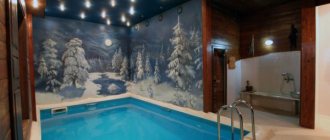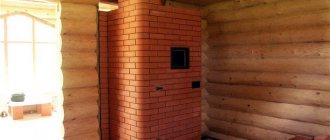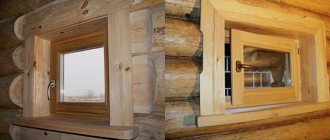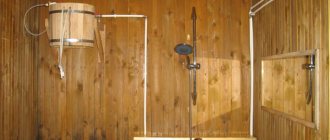Painting the floor in the bathhouse is the final stage of construction work. Often, high-quality and non-toxic materials with high physical and operational characteristics are used to paint flooring.
A bathhouse is a structure characterized by high humidity and sudden temperature changes, which can negatively affect coloring materials.
Modern baths have two types of floors - wooden and concrete. Therefore, when choosing paint and varnish products, it is important, first of all, to take into account the type of floor base.
Types of floors in the bathhouse
For baths characterized by high humidity and sudden temperature changes, as a rule, two types of floors are used:
- Wooden flooring.
- Concrete screed.
Concrete screed is often installed in steam rooms and washrooms. Ceramic tiles are usually laid on top of such a floor, choosing non-slip, durable and intended for rooms with high humidity levels.
Alternatively, when deciding how to cover the floor in a steam room, you can choose wooden lattice panels for laying on concrete, which will protect your feet from direct contact with the cold floor (pro
Types of premises
Fortunately, there are not many rooms in the bathhouse (in a standard one). Therefore, we will quickly go through the options of what paint to paint the inside of the bathhouse.
Steam room
This is the most problematic room. Many people believe that there is no need to paint anything there at all, but the price for such a decision is rapid darkening of the wood (and almost everyone has a steam room traditionally made of wood or lined with wood), cracking of the wood (this happens more often from poor ventilation during drying), susceptibility to rotting and mold damage (linden and aspen are very unstable species).
So the absence of any protective coatings, on the one hand, should be considered environmentally friendly, and on the other, costly in terms of future repairs.
We believe that a compromise is possible: there are absolutely safe impregnations that protect wood, preventing moisture and dirt from being absorbed. If you have doubts about whether it is worth using drying oils, take paraffin oil or another ready-made product intended specifically for the steam room.
You can paint the inside of the steam room with both paints and varnishes, but let them be water-soluble paints. And it would be nice if the label mentioning GOST standards stated that this composition is applicable in the steam room.
Washing
Both silicone and acrylic paints are suitable here. In general, everything that patiently endures the effects of moisture.
Other paints will crack and peel off in pieces under constant exposure to water.
ADVICE! Water dispersions do not tolerate frost well: if the water in the paint freezes, then after defrosting it will lose its quality. Therefore, buy them in the warm season, produced recently.
Impregnations and varnishes are also suitable for painting a sink. Again we draw your attention to scuba gear.
These rooms are the least demanding on the composition of paints, so it is best to proceed from budgetary considerations. If it doesn’t run out, you can give yourself a gift and use water-soluble paints again, otherwise, choose a paint that is suitable in color, dullness and durability of the coating from cheaper ones.
Of course, in the second case, it is better to paint when it is possible to ensure the best ventilation and the absence of people. Don't forget to use respiratory protection.
IMPORTANT! Remember that enamels and alkyd paints are fire hazards, but water-soluble paints are not.
Proper work with coating
When processing wooden floors, it is very important to correctly set priorities and strictly adhere to the sequence of technological processes, otherwise the floor will not only turn out to be imperfect, but will also very quickly become unusable.
In addition, when choosing what to cover wooden floors in a bathhouse with, you should not purchase materials from unverified manufacturers with questionable quality, otherwise you risk completely replacing all wooden elements.
Processing and finishing of the boardwalk in the dressing room and other rooms of the bath includes the following steps:
- Applying an antiseptic to protect against mold.
- Finishing with paints and varnishes.
Causes of wood rotting
Without special treatment, logs and floor boards begin to rot. In a bathhouse, as a rule, wood is used to finish floors, walls, ceilings, benches and shelves. That is why, without special treatment, logs and floor boards begin to rot. What are the main causes of rot in a room?
- poor waterproofing;
- lack of normal ventilation;
- high temperature and humidity;
- poor quality wood processing.
Some woods are more resistant to pathogens than others
Antiseptics
The main purpose of any antiseptic composition is to protect wood from rotting, mold, fiber destruction, and pest proliferation.
The operating conditions of any bath require constantly high humidity and high temperatures. All this has a detrimental effect on wood, so it is impossible to do without antiseptic treatment.
When choosing a suitable antiseptic, you should take into account that it must be intended specifically for use in baths, and also that it be produced by well-known companies on the market.
Impregnations are:
- Water soluble . This composition is optimal for treating walls in rest rooms and dressing rooms.
- With organic solvents . Surfaces treated with such impregnations acquire moisture resistance and increased strength. This composition is suitable for both interior and exterior decoration. In particular, if you don’t know how to treat the floor in a steam room, then this product is quite suitable for you.
- Oil based . Products from this category can only be used where there is no high humidity and no sudden temperature changes. You must first understand what is the best way to treat the bathhouse floor in your case.
- Combined use . The advantage of these compounds is that they simultaneously provide protection from both rot and fire.
Before treating the floor in the steam room or any other room in the bathhouse, you should thoroughly clean and dry the wood. Next, you should apply impregnation in several layers, paying special attention to the cut areas and joints. If damage by insects is detected, an alcohol-containing composition should be poured into the channels with a syringe, not forgetting the small area around the defective area.
However, it is a mistake to believe that one soak with an antiseptic will be enough. As the bath is used, any product is gradually washed away. Therefore, it is recommended to apply bath floor varnish over the antiseptic, preferably water-based.
Material requirements
It is desirable that the color of the paint emphasizes the texture of the wood and does not overlap its wood pattern. Which paint is suitable for painting floors in a “damp” room? Paint and varnish products intended for use in extreme conditions must have the following qualities:
- temperature stability;
- resistance to moisture;
- non-toxic;
- antifungal properties;
- resistance to mechanical damage.
In addition, it is desirable that the paint color emphasizes the texture of the wood and does not overlap its wood grain. To paint a concrete floor, you need to purchase compounds with dust-removing properties and good adhesion to mineral substrates. Otherwise, the protective layer will crack very quickly.
Applying varnish
The final stage of finishing any room is varnishing. However, the materials necessary for treating surfaces in a bathhouse are subject to special, increased requirements (for more details: “Which varnish to choose for baths and saunas - the differences and advantages of different compositions”).
The varnish must provide:
- absence of rotting due to increased effects of antiseptic impregnation;
- protect floors from any damage, including mechanical;
- safety for the health of humans and their pets;
- resistance to high humidity;
- no toxic fumes due to overheating.
Before covering the floor in a steam room with any chosen varnish, you should pre-treat the surface, that is, clean the wood from grease, dirt, dust, and remnants of old paints and varnishes. All cracks and irregularities in the floor must be puttied and then treated with an antiseptic.
After this, you can apply the varnish using a brush or roller - whichever is more convenient for you. The varnish should dry thoroughly, after which another layer can be applied if necessary. Please note that in the steam room you can only use varnishes that do not contain toxic substances released into the air when heated. Another important point is that the varnish must protect the coating from accidental fire as a result of a spark from the oven.
Types of paints
Water-based - moisture-resistant compositions that do not emit caustic chemicals when heated.
Paint and varnish products differ in their chemical composition, which affects their technical properties. Painting a bathhouse is possible using the following types of materials:
- Dispersion acrylics are quick-drying compounds that protect wood from moisture and mold. They do not interfere with the air exchange of wooden coverings with the environment. Using acrylic mixtures, you can paint floors both in the relaxation room and in the steam room;
- Oil-based – sensitive to high temperatures and UV rays. When heated, the paint may change color or become dull. For this reason, it is not advisable to apply them to coatings in steam rooms and washing baths. Oil paint is suitable for processing oak, linden and other types of wooden coverings, but only under conditions of moderate humidity and temperature changes;
- Water-based - moisture-resistant compounds that do not release caustic chemicals when heated. Painting the floor with this material will ensure more than 5 years of trouble-free operation of wooden coverings;
- Alkyds are inexpensive emulsions that quickly fade when exposed to high temperatures. They can be used for painting floors in a relaxation room, but not in a steam room or washing room.
Floor painting
Floors in bathhouses are often not only varnished, but also painted in order to further extend the life of the coating. However, when choosing what to paint the floor in a bathhouse with, you need to take into account that the paint must be safe for health, that is, not release toxins when heated. In addition, in the steam room it is better to do without paint at all.
If you need a product to paint the floor of a bathhouse in a washroom, make sure it meets the following requirements:
- ensured the formation of a thin protective film on the surface after application, preventing the accumulation of moisture, dirt and excessive overheating;
- prevented fungal growth and mechanical wear.
Before painting the floor in the dressing room, you should perform all the same preliminary procedures as when varnishing the surface.
Types of coatings
Let's look at all possible coatings, regardless of what material they are intended for, because this will be discussed below.
Antiseptic
Mold, unfortunately, does not make much difference between the materials on which it settles, and its harm to human health is a known thing. Therefore, it seems that surfaces need to be treated everywhere, but with some nuances.
IMPORTANT! Antiseptics are poisonous not only to mold, but also to humans!
Finnish bath paint Supi Lattiaolju
And we have said more than once or twice that elevated temperature is an excellent way to make all sorts of chemical hazards volatile, after which they enter your respiratory tract and poison your life.
On the other hand, we have to conclude that the Finns do not like themselves, because in the compositions intended specifically for the steam room, you will find the obligatory antiseptic. Or they found a product that does not evaporate at high temperatures. Or it evaporates, but does no harm. We have no more hypotheses.
In general, the conclusion from all that has been said so far is this: antiseptics are needed everywhere, including in the steam room. But we would still recommend using any type of separately sold antiseptics throughout the bathhouse, except for the steam room, and in the steam room only those paints that are intended only for it. Because we believe in GOSTs and other standards.
Fire retardant
This impregnation, of course, applies only to flammable materials, because it prevents them from igniting or does not allow them to maintain combustion. In general, the main application is the protection of wooden structures.
Fire retardant for interior and exterior treatment
There are only two classes of fire retardants - one suppresses fire for a short time, and if the temperature is exceeded, it loses ground and allows the tree to catch fire, the second is not afraid of heat, it actively protects the tree, releasing gases that cool the surface, creating a layer that prevents oxygen from reaching the wood.
The second class is not so much the composition as the method of impregnation. It should be deep, done under pressure, in general, work for a pro. But in practice, a composition is often used that can be applied manually, which ensures shallow impregnation. But even so, it’s good, because bathhouses burn most often.
INTERESTING! Fire retardants most often contain either boron or urea compounds.
Again we are talking about wood. This material has the ability to absorb water, which causes not only swelling, but also warping, and can cause rot. Therefore, it becomes important to make the wood hydrophobic.
Either oils or wax can cope with this task. Usually linseed oil, also known as drying oil, is used to impregnate wood, but it is not recommended to use drying oil in a steam room. Instead, you can use some store-bought mixture.
Moreover, ready-made formulations can be based either on natural oils or on petroleum distillation products - paraffin oil, for example.
It is also worth paying attention to oil emulsions - these are particles of fat suspended in water, which are convenient to apply to a wooden surface. In general, the consistency of oil impregnations can be different, including a solid substance if wax is added to it (then it is called “oil wax”).
It is assumed that impregnations of this kind are a good answer to the question “how to paint a bathhouse inside a steam room,” where they can cover shelves, and, if desired, walls, ceilings, frames, doors and even floors! After absorption and drying, the impregnation guarantees not only protection from water and wood cracking, but also dirt-repellent properties and color preservation.
If the impregnation is water based, it will have to be renewed more often. You will notice by a change in the properties of the wood that it is time to re-coat.
Dye
All types of paint and varnish products that can be found on the market are applicable in the bath. There are some reasonable restrictions, but not prohibitions.
In total, we have several classes of paints at our disposal:
- enamels;
- oil;
- water soluble.
Enamels are coatings that are so smooth and even that they resemble old enamels. In fact, these are varnishes with covering pigments, which gives an opaque and glassy layer. The varnishes used as the base of enamels are alkyd with various variations: simply alkyd (pentaphthalic and glyphthalic), alkyd-oil, alkyd-phenolic, alkyd-melamine.
In all cases, we are talking about flammable and toxic compounds, the use of which when painting the inside of a bathhouse is recommended only with the possibility of ventilation and the use of respiratory protection during the application process. When using enamel, limit its use to areas other than the steam room.
In fact, oil paints appeared first and a very long time ago - they are a mixture of pigments and drying oils, ultimately forming a hard, water-insoluble film. Typically, the base of oil paint was natural drying oil - for example, linseed oil that had undergone long-term heat treatment. However, over time, artificial drying oils based on alkyd resins appeared.
Today, oil paints can still be purchased, and they are very inexpensive, but they are also flammable, and the solvents used to dilute them have no health benefits.
The restrictions are the same as for enamels.
Water-soluble paints have different bases. These can be acrylic and silicone resins, as well as various composites when, for example, latex or polyurethane is added to acrylic.
Water-soluble paints are based on resins that dissolve well in water before polymerization, but after polymerization do not dissolve at all. (In this case, dissolution should be understood as the formation of a suspension of resin particles in water - similar to milk, for example.)
As mentioned above, paints appeared gradually - oil paints were known (in painting at least) centuries ago, enamels appeared during the intensive growth of the chemical industry, and the current water-based paints are a tribute to technical progress in ecology. In general, quality and safety are increasing as we approach today, but, unfortunately, the price is also increasing along with them.
ADVICE! However, we would still risk recommending water-dispersion paints for painting the inside of a bathhouse.
Varnishes are commonly used to coat wood because they provide (unlike paints) a transparent finish (in various shades as desired) that does not hide the natural grain of the wood.
By its nature, varnish is a resin or artificial polymer. Before application to the surface, it is maintained in liquid form by solvents, but they erode during application and the resin film hardens.
Solvents for varnishes were invented in a variety of ways, including different ones in toxicity. Today, water-soluble varnishes are the safest. This is still the same suspension of acrylates in water. However, it forms a transparent film.
Varnishes are used to cover any wooden surfaces, but if we are talking about floors, then you should take into account abrasion (the more people walk in the room, the more it is), and buy varnishes with high wear resistance.
In addition, there are varnishes that are suitable for wet rooms. They can be used in the washing room, and some even in the steam room.
Types of surfaces and material
Perhaps you don’t want to read the entire article because you are interested in a specific answer to an equally specific question - which paint composition is applicable to this or that part of the room - the ceiling or floor, or walls.
Ceiling
There are no specialized paints just for the ceiling. Usually ceilings are painted with the same paint that is suitable for walls.
If you have wooden ceilings, you may decide to coat them with varnish or acrylate, like Tikkurilov's Supi Saunasuoya.
ATTENTION! Ceiling varnish is suitable without additives that increase its wear resistance, which reduces its price.
If you don’t want to preserve the look and texture of wood, you can use any wall paint. Just remember that in wet rooms you should use paints with special markings. These could be silicone or acrylic paints for bathrooms, for example.
Where it is dry, you can paint the ceiling in a bathhouse with ordinary water-based paint, as for a living room.
There are only flooring options that can be found in a bathhouse - wood or concrete. The latter is found in damp rooms; it is not always covered with tiles, but as an alternative to tiles it is covered with special paints, for example, paint for concrete pools, which guarantees resistance to water and good adhesion (sticking) specifically to this material.
Paint for concrete pools Hydrostone
As for the wooden floor, here you still have the same choice - either use an opaque composition, or a transparent one - that is, paint or varnish. If the bathhouse is used frequently, then it makes sense to look for a coating with special additives that reduce its abrasion (polyurethane, urethane). Otherwise, you can save money on this.
In principle, the floor is the coldest part even in a steam room, so your choice is not limited by anything (except for humidity, which should be taken into account). You can use alkyd varnishes and paints, even oil-based ones if you want. Yacht varnishes are designed for direct action of water.
The floor in the steam room can be covered with Finnish paints - there are impregnations, varnishes, and acrylate protection on sale.
For those who would like to read more detailed material on floor paints and varnishes, read this article.
The material of the walls themselves can be very different: wood, brick, blocks. However, they do not remain unfinished, so you will paint either timber/framework, or lining, or, less likely, plaster. The bathhouse is traditionally decorated with wood, but we will still tell you about all the existing options, in case it comes in handy for someone.











